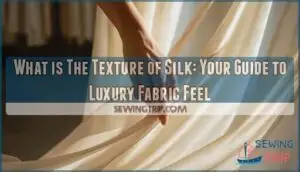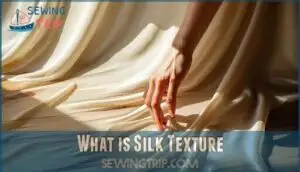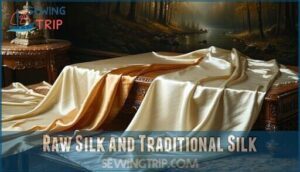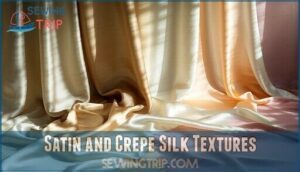This site is supported by our readers. We may earn a commission, at no cost to you, if you purchase through links.
 Silk’s texture is uniquely smooth and soft, yet it’s not slippery like synthetics.
Silk’s texture is uniquely smooth and soft, yet it’s not slippery like synthetics.
You’ll notice its natural sheen and breathable quality immediately upon touch. The fiber’s triangular cross-section creates that signature lustrous appearance while maintaining remarkable strength.
What makes silk special isn’t just how it feels—it’s hypoallergenic and has excellent moisture absorption. When you run your fingers across genuine silk, you’ll detect subtle irregularities that synthetic fabrics can’t replicate.
The texture varies depending on the weave: raw silk feels slightly nubby, while satin silk is incredibly smooth. Understanding these nuances helps you appreciate why silk commands premium prices and remains fashion’s most coveted luxury fiber.
Table Of Contents
Key Takeaways
- You’ll feel silk’s signature smoothness comes from its unique triangular fiber cross-section that creates natural light refraction and a cool touch against your skin.
- You can identify genuine silk through subtle irregularities and imperfections that synthetics can’t replicate – perfect smoothness actually indicates fake fabric.
- You’ll notice different silk types offer distinct textures: raw silk feels slightly nubby, satin silk provides mirror-like smoothness, and crepe silk has a matte, pebbled surface.
- You’ll find silk’s breathable and hypoallergenic properties combined with excellent moisture absorption make it superior to synthetic alternatives for comfort and skin health.
Silk Texture Overview
You’ll discover silk’s texture combines exceptional softness with a naturally smooth surface that feels cool against your skin.
This luxurious fiber offers unique breathability and hypoallergenic properties that set it apart from synthetic alternatives.
Softness and Smoothness
Nothing beats silk’s signature touch – those soft fibers create smooth texture that feels like luxury itself.
Silk’s caress against skin is pure indulgence—nothing compares to its natural elegance.
You’ll notice the gentle touch immediately when silk fabric meets your skin.
This smooth fabric offers a luxurious feel through its natural silk softness, making soft material an everyday indulgence that breathes beautifully.
Natural Sheen and Breathability
Silk’s natural luster comes from its triangular fiber cross-section that refracts light beautifully.
You’ll notice this creates a subtle, multi-tonal shimmer unlike synthetic fabrics’ single-tone gloss. The smooth fabric structure allows excellent breathability through airy weaves.
- Natural fibers in silk create superior moisture-wicking properties
- Silk breathability regulates temperature in both hot and cold conditions
- Soft textures maintain comfort without feeling sticky or artificial
- Breathable fabrics like silk prevent overheating during sleep or wear
Hypoallergenic Properties
Beyond its lustrous appeal, silk’s hypoallergenic properties make it a sanctuary for sensitive skin.
Natural silk fibers resist dust mites, mold, and mildew that trigger allergic reactions. These breathable fabrics won’t irritate like synthetic materials, offering gentle care for those prone to skin sensitivities.
The smooth texture prevents friction that causes breakouts, making silk ideal for allergy prevention and overall skin health comfort.
Silk’s unique properties also make it suitable for various silk textile applications, providing a sanctuary for sensitive skin with its breathable nature.
What is Silk Texture
Texture defines how your fingertips experience silk’s surface when you touch it.
You’ll notice silk texture combines multiple sensory elements: the smooth texture against your skin, fabric density that creates weight, and fiber structure that determines drape.
Silk feel varies dramatically between texture types – from raw silk’s slight roughness to crepe’s crinkled surface.
This luxurious feel comes from silk’s unique protein fibers, which create different tactile experiences depending on weaving techniques.
Understanding silk quality means recognizing how these elements work together to produce that distinctive soft texture you associate with premium fabrics, and how they contribute to the overall luxurious feel.
Silk Fiber Characteristics
You’ll discover silk’s unique texture comes from its triangular fiber cross-section, which creates that signature smoothness and natural sheen.
These microscopic structures pack tightly together at the molecular level, giving silk its legendary soft feel that’s both strong and luxurious against your skin.
Triangular Cross-Section
Precision defines silk’s unique appeal, stemming from its remarkable triangular cross section that creates the fabric’s signature characteristics.
Silk’s triangular fibers create an unmistakable luxury that synthetic fabrics simply cannot replicate.
This geometric fiber structure enables exceptional light refraction, giving silk its coveted luxurious feel and smooth texture that you’ll instantly recognize.
- Light-reflecting triangles: Each silk fiber’s three-sided shape acts like tiny prisms, bouncing light in multiple directions for that signature shimmer
- Enhanced molecular packing: The triangular cross section allows tighter fiber arrangement, creating silk’s incredibly soft texture against your skin
- Superior smoothness factor: Unlike round synthetic fibers, silk’s angular structure provides a naturally smooth texture without feeling slippery or artificial
- Distinctive silk feel: This unique fiber structure contributes to silk’s ability to feel cool, breathable, and luxuriously soft simultaneously
- Natural light play: The cross section creates subtle color variations and depth, making silk fabrics appear alive with movement and luminosity
Molecular Packing and Softness
Inside every silk fiber, protein chains pack together like perfectly organized building blocks.
This tight molecular bond creates silk’s legendary softness analysis reveals.
The fiber structure allows smooth contact with your skin, making silk texture feel luxurious yet gentle.
| Material Properties | Technical Aspect | Feel Result |
|---|---|---|
| Protein Chain Alignment | Parallel molecular arrangement | Smooth texture without roughness |
| Dense Fiber Packing | Compact molecular structure | Soft texture that’s never harsh |
| Natural Protein Bonds | Strong intermolecular forces | Durable silk feel over time |
| Uniform Fiber Density | Consistent molecular spacing | Even silk softness throughout |
This texture science explains why silk feels different from cotton or synthetic materials—it’s all about those tightly packed protein molecules working together.
Natural Sheen and Light Refraction
When light hits silk’s triangular cross-section fibers, you’ll see magic happen.
Each flat surface reflects light at different angles, creating that signature silk luster we all recognize.
This unique fiber optics effect produces a shimmering, pearl-like natural sheen that synthetic fabrics simply can’t match.
The refractive index changes constantly as silk smoothness moves, giving you that luxurious light reflection that makes silk shine so distinctively elegant.
The properties of silk fibre, including its silk fibre strength, contribute to its exceptional appearance and feel.
Types of Silk Textures
You’ll encounter several distinct silk textures, each with unique characteristics that affect how the fabric feels and drapes.
From the slightly coarse feel of raw silk to the mirror-like smoothness of satin weaves, understanding these texture variations helps you choose the right silk for your specific needs, considering the unique characteristics that each type of silk possesses.
Raw Silk and Traditional Silk
Raw silk emerges straight from cocoon harvesting, delivering an unrefined charm that’s surprisingly coarse yet authentic.
Traditional silk undergoes careful silk spinning and weaving processes, creating smoother textures through refined silk fibers.
The quality of raw silk is often determined by the raw silk fabric used in its production.
- Raw silk texture: Bumpy, nubby feel with natural imperfections from minimal processing
- Traditional dye absorption: Refined silk weave accepts colors more evenly than raw materials
- Fiber strength: Both types maintain durability, though traditional silk fabrics feel softer against skin
Silk-Wool Blends and Taffeta
Blending silk with wool creates textiles that marry silk’s smooth texture with wool’s warmth and structure.
These wool blends deliver enhanced softness while reducing wool’s scratchiness.
Taffeta fabric showcases silk weaving excellence through its crisp, lightweight feel and signature rustling sound.
This textile innovation produces fashion trends favoring structured silhouettes.
Both silk fabrics demonstrate superior texture properties for luxury applications.
The production of silk taffeta involves understanding silk fabric properties to achieve the desired texture and quality.
Satin and Crepe Silk Textures
Two distinct silk weave patterns create dramatically different textile experiences you’ll instantly recognize.
Satin weave produces that signature mirror-like satin luster through its float construction, while crepe finish delivers textured sophistication through twisted yarns.
- Satin texture: Glossy, smooth texture that reflects light beautifully
- Crepe silk: Matte finish with subtle pebbled fabric density
- Textile softness: Both offer luxurious comfort despite contrasting appearances
To achieve professional results when working with silk, understanding sewing silk techniques is essential for handling its unique properties.
Silk Texture and Drape
Silk’s texture creates a fluid drape that transforms any garment into an elegant statement piece.
You’ll notice how pure silk flows and conforms naturally to your body’s contours, while fiber blends and different weaves can dramatically alter the final silhouette, creating a unique fluid drape.
Fluid and Elegant Drape
Experiencing silk’s drape is like watching water flow through your fingers.
The silk texture creates soft ripples that cascade naturally, giving fabric movement an almost liquid quality.
You’ll notice how silk’s elegant fold follows your body’s contours, creating graceful lines.
This fluid fabric behavior makes silk feel luxurious against your skin, with smooth texture enhancing the overall silk softness experience.
Influence of Fiber Blend and Weave
Your silk’s drape depends on its fiber blend and weave patterns.
Pure silk threads create the most fluid movement, while silk-cotton blends offer structure with less flow.
Weaving techniques dramatically affect texture variations – satin weaves produce smooth, glossy surfaces, while plain weaves create more textured fabric density.
Different yarn textures and fabric weave combinations give you distinct draping characteristics.
Garment Silhouette and Contour
You’ll find silk’s natural fluidity transforms how garments fit your body.
The smooth texture creates beautiful contour fitting that follows your curves without clinging.
This fabric drape enhances any silhouette design, allowing garments to flow gracefully with movement.
Silk softness guarantees body conformity feels comfortable, never restrictive.
The silky texture’s elegant garment flow makes every piece appear effortlessly refined and flattering, with silk softness and natural fluidity creating a beautiful contour.
Silk Texture and Sustainability
You’re right to think about sustainability when choosing silk – the textile industry ranks as one of the world’s most polluting sectors, and traditional silk production carries significant environmental concerns.
Today’s eco-conscious consumers can find certified sustainable silk options that maintain the luxurious texture while supporting responsible farming practices and cleaner dyeing processes, which is a more eco-conscious approach.
Environmental Impact of Silk Production
Manufacturing luxury silk comes with hidden environmental costs that might surprise you.
Each kilogram requires 3,000 liters of water and generates 7.63kg CO2 equivalent emissions.
Silk production involves toxic chemicals like formalin and bleach, creating silk waste that pollutes groundwater.
While natural silk fibers are biodegradable, conventional sericulture practices damage ecosystems through pesticide use and monoculture farming, increasing the eco footprint substantially, which is a significant environmental cost.
Sustainable Silk Fabrics and Certifications
Looking for sustainable silk fabrics means you’re choosing textiles that protect both people and planet.
Green certifications like GOTS guarantee organic farming methods, while Fair Trade Practices guarantee ethical working conditions throughout silk production.
- GOTS Certification – Requires 70% organic fibers with strict environmental standards
- OEKO-TEX STANDARD 100 – Tests for over 1,000 harmful substances annually
- Peace Silk Labels – Guarantees humane treatment of silkworms during harvesting
These Eco Labels help you identify natural silk that maintains its luxurious silk texture while supporting sustainable production methods.
Eco-Friendly Dyeing and Finishing Processes
You’ll discover modern eco-friendly dyeing methods that preserve silk’s luxurious texture while protecting the environment.
Natural dyes from plants create vibrant colors without harsh chemicals. Organic finishing processes maintain silk properties through green chemistry techniques.
Eco printing uses botanical materials directly on natural silk. These sustainable practices guarantee your silk keeps its signature softness and sheen naturally.
The result is a product that not only looks beautiful but also supports environmental protection.
Identifying Genuine Silk Texture
You can distinguish authentic silk from synthetic fabrics through simple tests and careful observation.
Real silk has natural irregularities, a distinctive burn smell, and a cool, breathable feel that synthetic materials can’t replicate, which contributes to its unique breathable characteristics.
Burn Test and Authenticity
You can perform a burn test to verify silk authenticity through fiber analysis.
Extract a few threads and ignite them with tweezers.
Authentic silk burns slowly, smells like burning hair, and leaves powdery ash.
Fake detection reveals synthetic fabrics melt, smell chemical, and form hard residue.
This textile forensics method confirms genuine silk texture through specific burning behaviors and odor patterns.
Understanding the silk burn test is essential for identifying genuine silk fabrics.
Natural Irregularities and Imperfections
Authentic silk texture contains subtle fiber imperfections that reveal its natural origin.
You’ll notice silk slubs, tiny thickened sections where cocoon irregularities created texture variations.
These natural defects aren’t flaws—they’re silk’s fingerprint.
Perfect smoothness screams synthetic.
Real silk shows slight coarse texture spots alongside mainly smooth clothing areas, creating character that machines can’t replicate, which is a result of its unique natural origin.
Difference From Synthetic Fabrics
Think of silk texture as your fabric’s fingerprint – it’s completely unique. You can’t fake that natural smoothness and cool touch.
Here’s what sets real silk apart from synthetic alternatives:
- Temperature test: Real silk feels cool initially, while synthetics often feel warm or sticky
- Light dance: Genuine silk has subtle, shifting shimmer; synthetics show harsh, single-tone gloss
- Touch truth: Natural silk has gentle irregularities; synthetic fibers feel uniformly perfect but artificial
Fabric comparison reveals key differences through material science. Synthetic alternatives lack silk’s triangular fiber structure that creates its signature feel.
Textile innovation can’t replicate silk’s natural breathability and moisture-wicking properties. When conducting fiber analysis, synthetic fibers show different burn patterns and lack silk’s protein-based composition.
The smooth texture of real silk comes from its molecular packing, something synthetic fibers struggle to match despite advances in material science.
Silk Texture and Care
Understanding silk’s luxurious texture means knowing how to preserve it through proper care.
You’ll want to treat this delicate fiber with the right washing, drying, and storage techniques to maintain its signature smoothness and natural sheen for years, which involves handling it with care to preserve its luxurious texture.
Washing and Drying Guidelines
You’ll preserve silk’s luxury texture by hand washing with cool water and pH-neutral detergent.
Skip the harsh detergents that strip natural proteins. For delicate cycle machine washing, use mesh bags and gentle settings.
Dry cleaning works for structured garments, but air drying maintains silk softness best. Never wring or twist wet silk—gently squeeze excess water and lay flat on clean towels for ideal fabric softening and care.
When choosing a detergent, consider using a silk wash product to protect the fabric, ensuring the silk’s luxury texture is preserved with gentle settings and pH-neutral detergent.
Ironing and Steaming Techniques
Steam-touch method preserves silk texture by relaxing fibers naturally.
Use low-heat iron with pressing cloth, never direct contact.
Steaming is gentler for wrinkle removal—hold steamer 6 inches away.
Iron silk inside-out on silk setting, moving continuously to prevent shine spots.
Let fabric breathe between passes for ideal silk finishing results.
To achieve professional-looking silk fabric, understanding silk press techniques is essential for maintaining its texture and appearance.
Storage and Maintenance Tips
Store silk garments in breathable cotton bags or acid-free tissue paper to maintain silk softness.
Keep your closet organization system humidity-controlled below 60% for pest prevention. Cedar blocks naturally repel insects without chemical damage.
Fold silk loosely along seams to prevent creasing. Avoid plastic storage—it traps moisture and causes mildew.
Regular air circulation preserves that luxurious texture you love, and using breathable cotton bags can help. Acid-free tissue paper is also a good option for storing silk garments.
Silk Texture in Fashion
You’ll discover silk’s remarkable texture transforms high-end fashion through its natural elegance and versatility.
From haute couture gowns that flow like liquid to contemporary designer pieces, silk’s unique feel creates garments that move beautifully with your body while maintaining their luxurious appeal.
Luxury and High-End Fashion
Luxury brands showcase silk’s unmatched texture to create timeless pieces that define sophistication.
The smooth texture and natural sheen make silk the ultimate choice for exclusive designs.
Here’s why luxury fashion embraces silk texture:
- Premium feel – Silk softness elevates any garment’s perceived value
- Versatile drape – Works perfectly for flowing evening wear and structured pieces
- Status symbol – Couture houses rely on silk’s reputation for exclusivity
Fashion trends consistently return to silk because its texture speaks luxury without saying a word.
Silk Fabrics in Haute Couture
In haute couture, silk weaving reaches its artistic peak through intricate silk embroidery and hand-finished details.
Luxury textiles showcase silk’s exceptional drape and silk softness, allowing designers to sculpt breathtaking silhouettes.
The silk feel becomes paramount—each silk fabric must flow like liquid poetry.
Fashion trends embrace silk’s natural texture, with couturiers selecting specific silk weave patterns to achieve their vision.
Emerging Trends and Designer Collaborations
You’ll discover exciting developments in silk’s future through bold Designer Silk partnerships and Fashion Tech innovations.
Luxury Brands like Gucci collaborate with artists, while sustainable fashion drives Eco Trends in lab-grown alternatives.
These partnerships enhance silk texture through smart textiles and biodegradable embellishments, creating rich and smooth texture experiences that blend heritage craftsmanship with modern innovation.
The use of unique fabric textures is becoming increasingly important in the design process, as it allows for greater creativity and expression in the final product.
Frequently Asked Questions (FAQs)
Is silk smooth or rough?
Silk is exceptionally smooth, not rough.
You’ll feel its signature softness and luxurious texture against your skin.
The fine fiber structure creates a gentle, non-slippery surface that’s remarkably comfortable and breathable.
How would you describe silk?
Imagine running your fingers across nature’s most luxurious thread—you’ll discover silk’s signature smoothness that’s never slippery.
Its fine molecular structure creates an exceptionally soft, featherlight touch that feels cool and breathable against your skin.
What texture is similar to silk?
You’ll find cashmere, modal, and bamboo fabric share silk’s luxurious smoothness.
High-quality cotton sateen and certain synthetic blends can mimic silk’s cool, flowing texture, though they lack its natural temperature regulation properties.
Why does some silk feel rough?
Rough silk catches you off guard, doesn’t it?
Raw silk retains sericin protein coating from cocoons, creating coarse texture.
Lower-grade fibers, damaged processing, or wild silk varieties naturally feel rougher than refined mulberry silk you’d expect.
How does silk texture change with age?
Over time, you’ll notice silk’s fibers gradually weaken and break down from UV exposure, friction, and natural aging.
The once-smooth texture becomes slightly rougher, losing some luster and developing a more fragile feel.
Does humidity affect silks tactile properties?
Yes, humidity substantially affects silk’s tactile properties.
You’ll notice silk becomes softer and more pliable in humid conditions as it absorbs moisture, reaching up to 11% moisture regain, which enhances its natural smoothness and drape.
Can silk texture indicate thread count quality?
Incredibly precise thread count won’t magically reveal silk’s quality through texture alone.
You’ll feel smoother, denser weaves with higher counts, but texture depends more on fiber grade and processing than pure thread density.
Why does silk feel different when wet?
When silk gets wet, you’ll notice it becomes heavier, loses its natural sheen, and feels slightly rougher.
The fibers absorb moisture, changing their structure temporarily and reducing that signature smooth glide until completely dry, which is a key aspect of how silk reacts to moisture, particularly affecting its natural sheen.
How do weaving patterns alter silk texture?
Weaving patterns dramatically transform silk’s surface texture by altering how fibers interact with light and touch.
Satin weaves create glossy, mirror-like smoothness, while plain weaves produce more matte finishes.
You’ll notice twill patterns add subtle ridges.
Conclusion
Like telegraph operators of old transmitting precious messages across continents, you’ve now learned to decode what’s the texture of silk through its unique characteristics.
Silk’s triangular fibers create that distinctive smooth feel with natural irregularities you can’t find in synthetics.
Whether you’re choosing raw silk’s subtle nubby texture or satin’s liquid-smooth finish, understanding these qualities helps you make informed fabric decisions.
Remember the burn test and feel for those telltale imperfections when authenticating genuine silk.
- https://blissy.com/blogs/the-blissy-blog/what-does-silk-feel-like-discover-the-differences-and-characteristics
- https://www.parisera.com/blogs/crafts-and-weaves/understanding-the-texture-of-silk-sarees
- https://fashionandtextiles.springeropen.com/articles/10.1186/s40691-023-00368-2
- https://alnassaj.com/the-definitive-guide-to-silk-fabric-types-uses-and-care/
- https://pmc.ncbi.nlm.nih.gov/articles/PMC5832731/


















